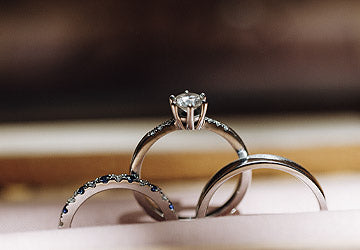The emerald cut diamond is a classy and timeless style of diamond cut that carries a vintage aesthetic. The emerald diamond is a popular choice for engagement rings and other jewelry pieces, and it is often confused with an Asscher cut. The sharp angles and elongated shape of an emerald are a distinctive choice for a distinctive individual.
Learn everything you need to know about the emerald cut diamond and its characteristics. Learn about the history behind it, as well as what makes it distinctive from other contemporary diamond cuts. And discover some tips from professional jewelers on what to look for when shopping for your diamond.
WHAT ARE EMERALD CUT DIAMONDS?
An emerald cut diamond is distinguished and distinctive amongst other cuts, because of its unmistakable shape. No other diamond cut can be confused with an emerald, except for an Asscher cut diamond. And, the only difference is that an Asscher is square, and an emerald cut is rectangular.
An emerald cut features cascading parallel facets that converge like a concave step pyramid. The optical illusion of this cut creates a diamond that looks larger than its carat weight. Thus, they appear as a large, opulent, and decadent fashion choice, as is indicative of the emeralds height of popularity through America's roaring 20s.
THE HISTORY OF THE EMERALD CUT: WHERE DOES IT COME FROM?
The shape of an emerald cut diamond comes from the original emeralds from the 16th century. Emerald gemstones are fragile, which led the stonecutters of the day to discover a way to strengthen their valuable cargo. When cut with stepped facets running parallel along with the stone, it retained more structural integrity and was more stable to transport from the mine.
When viewed from above, the emerald cut appears to recede in a stepwise pattern. The original stonecutters thought it looked like the Aztec step pyramids. Today, this style of cut produces a diamond with exceptional white and colored light reflection.
WHAT IS THE IDEAL LENGTH TO WIDTH RATIO OF AN EMERALD CUT?
An essential aspect of consideration to the quality of your emerald cut diamond is the length to width ratio. If the ratio is too close, your emerald diamond might be confused with an Asscher diamond. The only difference between the Asscher and emerald cut is that an Asscher cut is perfectly square.
Therefore, to appear as an emerald, and not an Asscher, the length to width ratio should ideally be 1:3 to 1:6. If the length to width ratio of an emerald diamond comes in below 1:3 it looks too much like an Asscher cut diamond. But, the best length to width ratio of an emerald cut also depends on the setting for the diamond.
WHAT IS THE BEST SETTING FOR AN EMERALD CUT DIAMOND?
An emerald cut diamond exudes sophistication and elegance, which does not need to be upstaged by the ring setting. In general, when looking for a setting for an emerald cut, less is more. The setting should allow the diamond to stand out.
A solitaire, pave, or other three-stone settings should complement the diamond nicely. If you want to embrace a vintage aesthetic, consider an emerald shape with a halo setting. A halo setting evokes an art deco look and brings out the emeralds sparkle.
OVERALL PROS AND CONS TO EMERALD SHAPE DIAMONDS
In general, emerald cuts are reasonably priced and widely available to jewelers. But, the style often has a glassy nature to the stone, which can make for more visible inclusions and imperfections. And, the emerald falls much shorter than other contemporary cuts when it comes to brilliance.
But, if you want a dressed-up, classic vintage style diamond, the emerald cut brings out the drama. And, the only way to truly appreciate the characteristics of an emerald diamond is to do an optical comparison for yourself. Talk to an Impress Jewelers associate to schedule a visit and see the differences between an emerald cut diamond and a round brilliant first-hand, or design your custom ring in the online shop.





